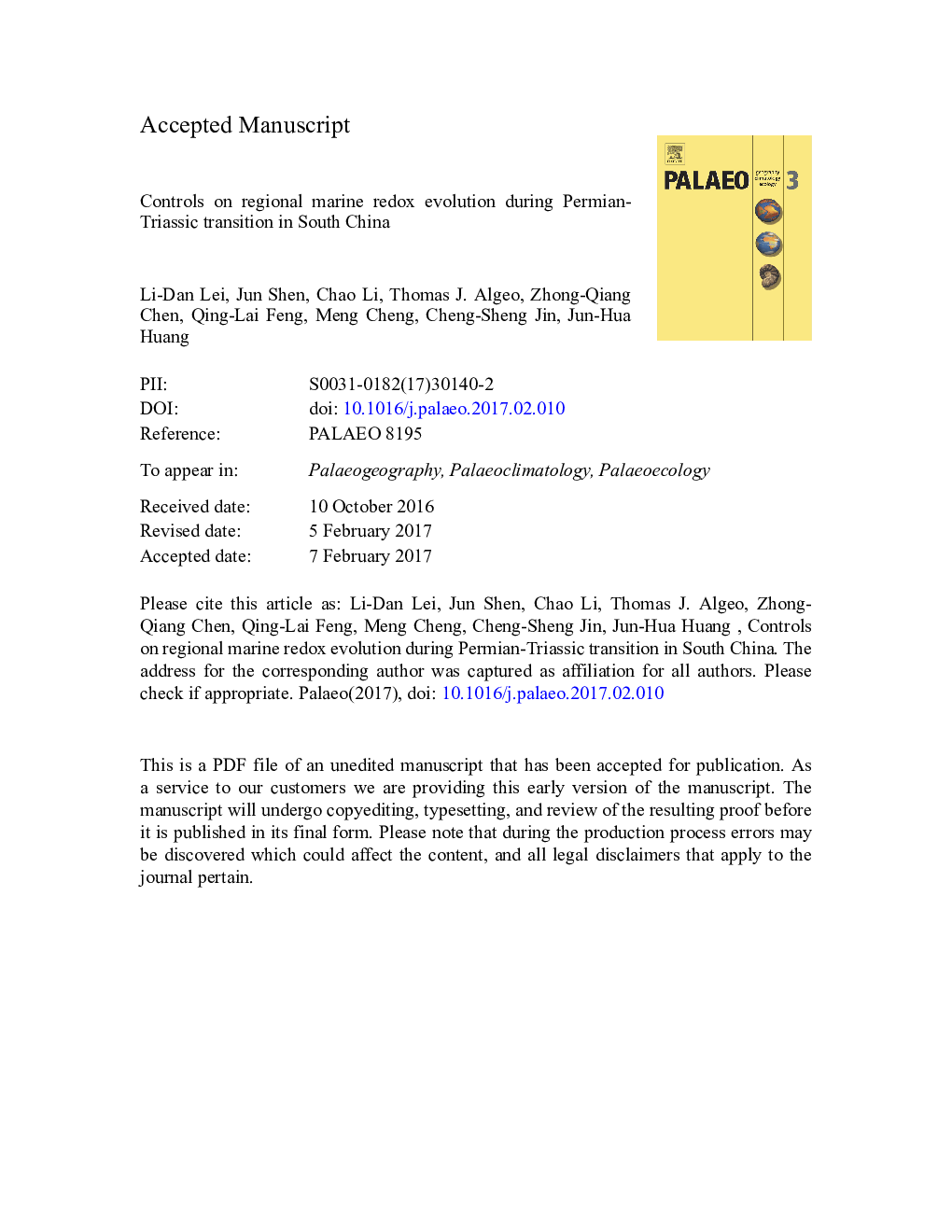| کد مقاله | کد نشریه | سال انتشار | مقاله انگلیسی | نسخه تمام متن |
|---|---|---|---|---|
| 8868609 | 1622106 | 2017 | 53 صفحه PDF | دانلود رایگان |
عنوان انگلیسی مقاله ISI
Controls on regional marine redox evolution during Permian-Triassic transition in South China
ترجمه فارسی عنوان
کنترل در تکامل دریایی منطقه ای دریایی در طول انتقال پرییم تریاس در جنوب چین
دانلود مقاله + سفارش ترجمه
دانلود مقاله ISI انگلیسی
رایگان برای ایرانیان
کلمات کلیدی
اکسینیا، نوع خاص آهن، شار و هوای فشرده، ایزوتوپهای گوگرد، مرز پرمین-تریاس، انقراض جمعی،
موضوعات مرتبط
مهندسی و علوم پایه
علوم زمین و سیارات
فرآیندهای سطح زمین
چکیده انگلیسی
Although oceanic anoxia is regarded as a leading cause of the Permian-Triassic boundary (PTB) mass extinction, its timing, extent, and underlying causes remain unclear. Here, we conducted a high-resolution Fe-S-C-Mo geochemical study of the entire Changhsingian and lowermost Induan succession in a carbonate-ramp setting at Ganxi, western Hubei Province, South China. Six stratigraphic units representing discrete redox intervals were identified based on integrated Fe-S-C-Mo data. Units I-III are of latest Wuchiapingian to early Changhsingian age, with Units I and III characterized by euxinia and Unit II by uncertain redox conditions. Unit IV, of mid-Changhsingian age, records a gradual transition from euxinic to ferruginous conditions. Units V and VI, spanning the latest Permian mass extinction (LPME) to earliest Triassic interval, were deposited under dominantly ferruginous conditions punctuated by both euxinic and oxic episodes. Redox variations at Ganxi were controlled by contemporaneous oceanographic changes in the upper oceanic thermocline region: (i) euxinia in Units I and III may record elevated marine productivity (as suggested by mean organic carbon accumulation rates, or OCAR, of 6.5 and 5.1Â mg/cm2/kyr, respectively) that was possibly related to upwelling; (ii) the euxinic-to-ferruginous transition from Unit IV to Units V-VI can be attributed to a combination of reduced sulfate availability and rising terrigenous iron inputs (mean Fe of 1.7% and 3.9%, respectively, for Units V-IV and VI compared to 1.0% for Units I-III); and (iii) transient intervals of euxinia in Units V and VI were facilitated by enhanced sulfate fluxes related to episodic volcanism during this interval. An integration of the redox data from Ganxi with previously published data from the Shangsi and Xiakou sections suggests that enhanced weathering fluxes were most likely the key factor controlling the marine redox transition from euxinic to ferruginous conditions during the latest Permian across the South China region.
ناشر
Database: Elsevier - ScienceDirect (ساینس دایرکت)
Journal: Palaeogeography, Palaeoclimatology, Palaeoecology - Volume 486, 15 November 2017, Pages 17-32
Journal: Palaeogeography, Palaeoclimatology, Palaeoecology - Volume 486, 15 November 2017, Pages 17-32
نویسندگان
Li-Dan Lei, Jun Shen, Chao Li, Thomas J. Algeo, Zhong-Qiang Chen, Qing-Lai Feng, Meng Cheng, Cheng-Sheng Jin, Jun-Hua Huang,
